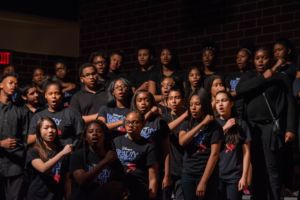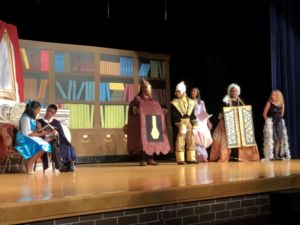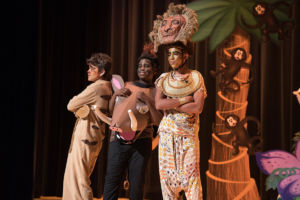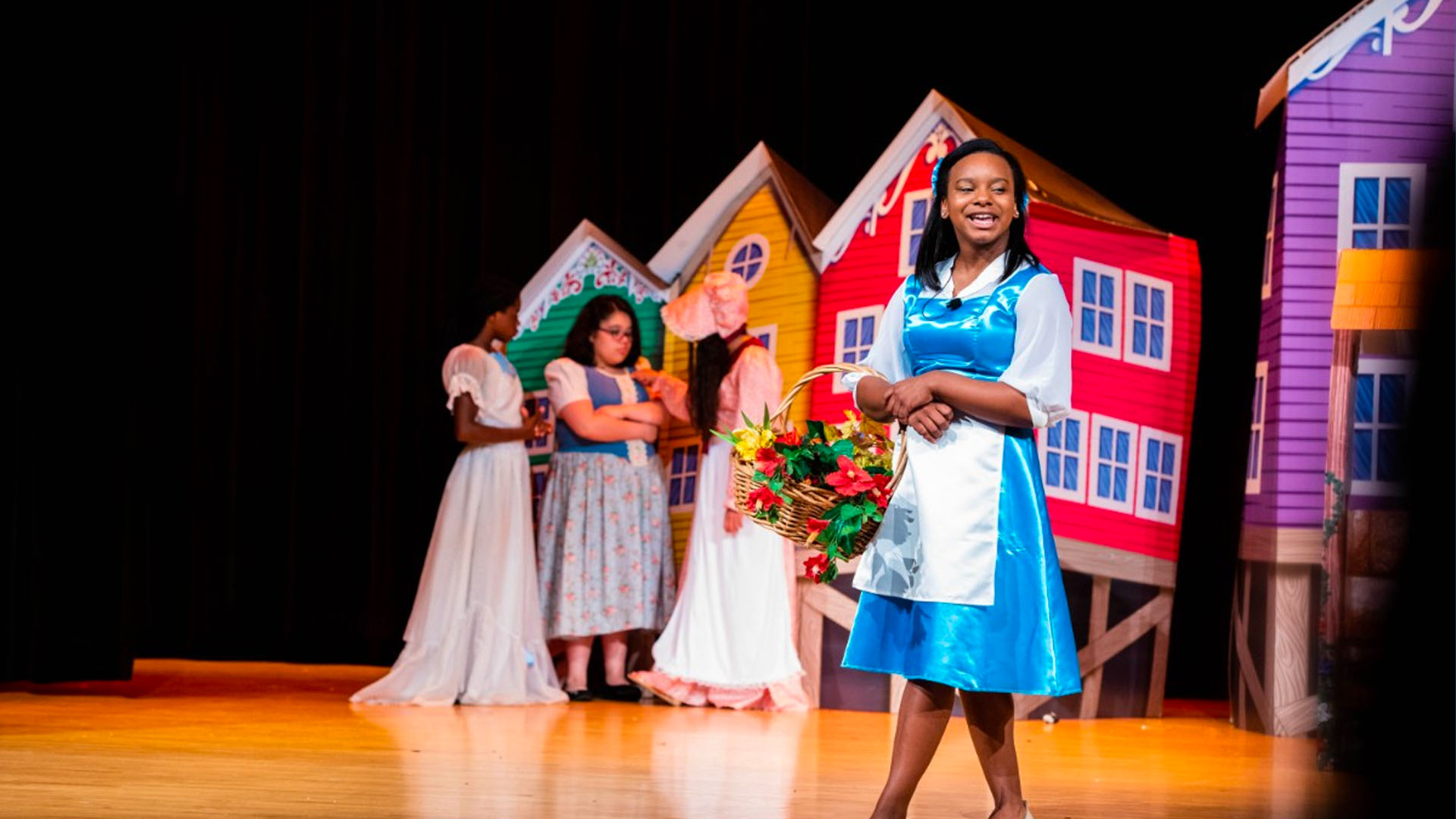Musical theater and I have a complicated relationship that began when I was in the third grade. Allow me to set the scene for you. The year was 1994, and it was Christmas. Our Sunday school class was eagerly preparing for a Nativity production, and I had my sights set on starring as the only leading lady in the show: Mary, the mother of Jesus. I wanted the role of Mary more than anything. Whoever was selected to play her would get to wear a beautiful costume, sing a solo of Silent Night (my favorite carol), hold the baby Jesus – which had the potential of being a real baby that year, AND be “married” to the cutest boy in our Sunday school class. We will call him “Billy.” I was sure he would get the role of Joseph because he was so cute and one of the oldest boys in our class. In my third grade mind, this was the perfect recipe for a good Joseph.  As auditions approached, I practiced my heart out and was confident there would be nothing standing in the way of me and my first major role in a musical production. Unfortunately, our Sunday school teacher, who was also my mother, saw things differently. When it came time to announce who got the role of Mary, my third grade hopes and dreams quickly came crashing down. Sadly, I was not cast as the mother of Jesus and leading lady of the Christmas season. Instead, I was cast as…. a sheep. Yes, you read that correctly. I earned the role of a sheep in our 1994 Sunday school production of the Nativity story, and it was one of the few, select parts with no speaking lines. No Silent Night for me. No potential of holding a real baby on stage. My costume was not a pretty blue robe but instead a white sweatsuit with about a hundred cotton balls hot glued to it. To add insult to injury, I had to crawl on all fours down the church aisle behind Billy’s younger brother, Josh, who was playing a shepherd. This is my first memory of being in a musical, and despite my lackluster role and utter disappointment in casting – I have grown to love them and have used them to empathetically teach social and emotional (SEL) strategies and state standards to my students as a music educator. I teach multiple state and music standards through a Broadway Jr. musical every other year. This allows for every student to be able to participate in at least one show, but also ensures I don’t burn myself out in the process. We do a “dinner theater style” show with seating at tables and provide a dessert and coffee/hot tea bar for the audience at intermission. I typically have about 200 students in my choir program, and I have created roles for every one of them. We start auditions in early September and have the show in early May. Having the year to prepare and rehearse allows for a nice pace in scheduling rehearsals and helps us execute the show with excellence.
As auditions approached, I practiced my heart out and was confident there would be nothing standing in the way of me and my first major role in a musical production. Unfortunately, our Sunday school teacher, who was also my mother, saw things differently. When it came time to announce who got the role of Mary, my third grade hopes and dreams quickly came crashing down. Sadly, I was not cast as the mother of Jesus and leading lady of the Christmas season. Instead, I was cast as…. a sheep. Yes, you read that correctly. I earned the role of a sheep in our 1994 Sunday school production of the Nativity story, and it was one of the few, select parts with no speaking lines. No Silent Night for me. No potential of holding a real baby on stage. My costume was not a pretty blue robe but instead a white sweatsuit with about a hundred cotton balls hot glued to it. To add insult to injury, I had to crawl on all fours down the church aisle behind Billy’s younger brother, Josh, who was playing a shepherd. This is my first memory of being in a musical, and despite my lackluster role and utter disappointment in casting – I have grown to love them and have used them to empathetically teach social and emotional (SEL) strategies and state standards to my students as a music educator. I teach multiple state and music standards through a Broadway Jr. musical every other year. This allows for every student to be able to participate in at least one show, but also ensures I don’t burn myself out in the process. We do a “dinner theater style” show with seating at tables and provide a dessert and coffee/hot tea bar for the audience at intermission. I typically have about 200 students in my choir program, and I have created roles for every one of them. We start auditions in early September and have the show in early May. Having the year to prepare and rehearse allows for a nice pace in scheduling rehearsals and helps us execute the show with excellence.  Students interested in main character roles must audition in front of a panel of judges made up of colleagues and music teachers from other schools. Those who like to dance are given dancing roles to show off their skills in the big, musical numbers. Those who love to sing are in the choir who stay on the wing of the stage throughout the performance. They stand on risers and wear the officially licensed broadway t-shirt of the show with black pants as their costume. Those who want to stay behind the scenes and not out in front of the audience have the option of working the curtain or pushing sound cues in the booth. No matter personal interests, personality, or ability level- I am a firm believer there is a spot for everyone in a musical. However, I have been teaching long enough to know that you may be reading this and think, “That is great, Amy, but you don’t know my students. How do I find a spot for the students who are in my class but do not participate or have major behavior issues?” The answer to your question lies in great communication and skillful presentation. When introducing the musical for the year, I talk up the role of “server” to my students, and it has quickly become the most coveted role in the show. The “servers” act as ushers and are in charge of a section of tables each night to answer any questions audience members might have such as restroom locations and exits. They are also the ones who get to pass out the desserts to their section during the musical number right before intermission and refill water glasses. I give an Academy Award-winning performance in presenting how special this spot is and how responsible the students must be in order to be considered, and believe it or not – it has worked like a charm every year. I have found that even the worst-behaved student in class likes to be helpful if given the chance, and if they are kept busy with their section each performance- there are no behavior issues. Everybody wins.
Students interested in main character roles must audition in front of a panel of judges made up of colleagues and music teachers from other schools. Those who like to dance are given dancing roles to show off their skills in the big, musical numbers. Those who love to sing are in the choir who stay on the wing of the stage throughout the performance. They stand on risers and wear the officially licensed broadway t-shirt of the show with black pants as their costume. Those who want to stay behind the scenes and not out in front of the audience have the option of working the curtain or pushing sound cues in the booth. No matter personal interests, personality, or ability level- I am a firm believer there is a spot for everyone in a musical. However, I have been teaching long enough to know that you may be reading this and think, “That is great, Amy, but you don’t know my students. How do I find a spot for the students who are in my class but do not participate or have major behavior issues?” The answer to your question lies in great communication and skillful presentation. When introducing the musical for the year, I talk up the role of “server” to my students, and it has quickly become the most coveted role in the show. The “servers” act as ushers and are in charge of a section of tables each night to answer any questions audience members might have such as restroom locations and exits. They are also the ones who get to pass out the desserts to their section during the musical number right before intermission and refill water glasses. I give an Academy Award-winning performance in presenting how special this spot is and how responsible the students must be in order to be considered, and believe it or not – it has worked like a charm every year. I have found that even the worst-behaved student in class likes to be helpful if given the chance, and if they are kept busy with their section each performance- there are no behavior issues. Everybody wins.  What I love most about teaching through musicals is how the learning process extends beyond musical notation and singing technique to teach life skills to students of any ability level. Musicals are a fantastic way for our students to learn performance skills and grow in social and emotional learning. Musicals help students learn to work together to accomplish a common goal through collaboration with others. Musicals help children overcome feelings of anxiety and learn to process constructive criticism in a healthy way. They help students work through feelings of fear and develop self-awareness. They promote responsibility by giving every child a task or goal to accomplish for the success of the group. Do you have a student in class who is really quiet but consistently gives their best and demonstrates responsibility? Lighting and sound or curtains might be their niche. Do you have a student who is a class clown or consistently gets in trouble in the hallways for being too loud? Acting might just be the perfect outlet for them to be positively rewarded for their comedic timing and vocal projection. Do you have an ELL student who struggles with learning English? Perhaps giving them a role in costuming and props could be beneficial for them to learn English terminology such as “hat”, “ball”, or “coat” in a tangible, non-threatening way. Again- the opportunities for every student to thrive in a musical production are endless. However, in order to produce a musical and create these experiences, you must first know how to get started. In order to do so, let’s start at the very beginning. A great musical starts with great planning. The first step I would recommend is to explore material listed by a licensing agency. I have a standard licensing agency in New York that has been an incredible resource to help get me started and guide me through the process. What I love most about this particular licensing agency is that you can request “perusals” allowing you to read through the show, look at the music, and decide if it is a good fit for you and your students prior to making a purchase. They also accept school purchase orders. Licensing and copyright are very important, and you want to make sure you understand what you legally can and cannot do in your production. Once you have selected a show for your school, I would then suggest meeting with your administrator and treasurer to discuss budget, rehearsal and performance dates, and any district policies which have the potential to affect your production. Clear communication from all invested parties is key, and assumptions will lead to issues every time. By meeting with your administrator and treasurer, you might find you have options available that you were unaware of.
What I love most about teaching through musicals is how the learning process extends beyond musical notation and singing technique to teach life skills to students of any ability level. Musicals are a fantastic way for our students to learn performance skills and grow in social and emotional learning. Musicals help students learn to work together to accomplish a common goal through collaboration with others. Musicals help children overcome feelings of anxiety and learn to process constructive criticism in a healthy way. They help students work through feelings of fear and develop self-awareness. They promote responsibility by giving every child a task or goal to accomplish for the success of the group. Do you have a student in class who is really quiet but consistently gives their best and demonstrates responsibility? Lighting and sound or curtains might be their niche. Do you have a student who is a class clown or consistently gets in trouble in the hallways for being too loud? Acting might just be the perfect outlet for them to be positively rewarded for their comedic timing and vocal projection. Do you have an ELL student who struggles with learning English? Perhaps giving them a role in costuming and props could be beneficial for them to learn English terminology such as “hat”, “ball”, or “coat” in a tangible, non-threatening way. Again- the opportunities for every student to thrive in a musical production are endless. However, in order to produce a musical and create these experiences, you must first know how to get started. In order to do so, let’s start at the very beginning. A great musical starts with great planning. The first step I would recommend is to explore material listed by a licensing agency. I have a standard licensing agency in New York that has been an incredible resource to help get me started and guide me through the process. What I love most about this particular licensing agency is that you can request “perusals” allowing you to read through the show, look at the music, and decide if it is a good fit for you and your students prior to making a purchase. They also accept school purchase orders. Licensing and copyright are very important, and you want to make sure you understand what you legally can and cannot do in your production. Once you have selected a show for your school, I would then suggest meeting with your administrator and treasurer to discuss budget, rehearsal and performance dates, and any district policies which have the potential to affect your production. Clear communication from all invested parties is key, and assumptions will lead to issues every time. By meeting with your administrator and treasurer, you might find you have options available that you were unaware of.  In general, I have found clear communication along with knowing how much money you have to work with helps tremendously in the planning process. It also adds clarity in what steps to take in order to help make the show happen. If funds are low, grants and fundraisers are a great way to compensate and provide independence for your program. Rights and production materials will cost anywhere from $600- $1100 depending on what materials you might need, but do not let the price deter or scare you. If you are truly interested in having a quality musical experience for your students there are options available to help you accomplish this with some effort and what my grandpa used to refer to as “elbow-grease”. I have found grants and a one-time, yearly fundraiser have made the most impact for my choir program. They involve hard work, but we would not have been able to do our musicals without them. Additionally, the time spent applying for grants and organizing our fundraiser is minimal compared to what it would cost to create, build, and design all of our set pieces for every show. The money raised has allowed us to work smarter and not harder by renting or purchasing the material to make what we are unable to rent. There are many ways to raise the funding needed to cover your costs, and I look forward to exploring this in my next article on the musical process. After meeting with your administrator and treasurer, I recommend making a list of your resources. This includes material resources that you might already have on hand such as paint supplies and fabric but more importantly- your relational resources such as fellow directors, community members, parents, and colleagues. Relationships are key in obtaining help from those around you, and you might be surprised at how many opportunities are so close by.
In general, I have found clear communication along with knowing how much money you have to work with helps tremendously in the planning process. It also adds clarity in what steps to take in order to help make the show happen. If funds are low, grants and fundraisers are a great way to compensate and provide independence for your program. Rights and production materials will cost anywhere from $600- $1100 depending on what materials you might need, but do not let the price deter or scare you. If you are truly interested in having a quality musical experience for your students there are options available to help you accomplish this with some effort and what my grandpa used to refer to as “elbow-grease”. I have found grants and a one-time, yearly fundraiser have made the most impact for my choir program. They involve hard work, but we would not have been able to do our musicals without them. Additionally, the time spent applying for grants and organizing our fundraiser is minimal compared to what it would cost to create, build, and design all of our set pieces for every show. The money raised has allowed us to work smarter and not harder by renting or purchasing the material to make what we are unable to rent. There are many ways to raise the funding needed to cover your costs, and I look forward to exploring this in my next article on the musical process. After meeting with your administrator and treasurer, I recommend making a list of your resources. This includes material resources that you might already have on hand such as paint supplies and fabric but more importantly- your relational resources such as fellow directors, community members, parents, and colleagues. Relationships are key in obtaining help from those around you, and you might be surprised at how many opportunities are so close by.  For example, my group hip hop instructor at the YMCA has choreographed several songs in shows and performances for my students. Our 6th grade social studies teacher has a minor in art and has built and painted incredible set pieces. A local boutique partnered with us to provide incredible costuming for a recent show at a highly discounted rate. Each of these resources was close and available. I just had to look around and ask, and that is perhaps the biggest challenge for music educators. We often feel as though our programs are a reflection of us and that asking for help is a sign of weakness. I tend to feel like my own, one-woman show at times, and when I examine what a musical entails- I realize I cannot do it all on my own. I am not a dance instructor with a degree in art and talents in costume and set design. I have to know my strengths and ask for help in areas of weakness. Asking for help sets you up for a strong program and investment from your school and community. The greater the investment, the greater the reward. If you look for the opportunities and resources around you, you’ll never walk alone. My start in musical theater was shaky, but the lessons learned along the way have been worth it. Whether a student is the lead or a sheep- musicals are a great way to engage all learners. They teach state music standards, help develop SEL strategies in fun and creative ways, and provide opportunities for community engagement. In the next piece, we will dive into the nuts and bolts of the audition process as well as practical rehearsal techniques, expectations, and effective communication. If you have any questions or would like support in starting the musical process – I would be so happy to chat with you. My email is: ALKamwendo@pike.k12.in.us. To quote Rodgers and Hammerstein, “so long, and farewell!”
For example, my group hip hop instructor at the YMCA has choreographed several songs in shows and performances for my students. Our 6th grade social studies teacher has a minor in art and has built and painted incredible set pieces. A local boutique partnered with us to provide incredible costuming for a recent show at a highly discounted rate. Each of these resources was close and available. I just had to look around and ask, and that is perhaps the biggest challenge for music educators. We often feel as though our programs are a reflection of us and that asking for help is a sign of weakness. I tend to feel like my own, one-woman show at times, and when I examine what a musical entails- I realize I cannot do it all on my own. I am not a dance instructor with a degree in art and talents in costume and set design. I have to know my strengths and ask for help in areas of weakness. Asking for help sets you up for a strong program and investment from your school and community. The greater the investment, the greater the reward. If you look for the opportunities and resources around you, you’ll never walk alone. My start in musical theater was shaky, but the lessons learned along the way have been worth it. Whether a student is the lead or a sheep- musicals are a great way to engage all learners. They teach state music standards, help develop SEL strategies in fun and creative ways, and provide opportunities for community engagement. In the next piece, we will dive into the nuts and bolts of the audition process as well as practical rehearsal techniques, expectations, and effective communication. If you have any questions or would like support in starting the musical process – I would be so happy to chat with you. My email is: ALKamwendo@pike.k12.in.us. To quote Rodgers and Hammerstein, “so long, and farewell!”
Resources
Please login or register to claim PGPs.
Alternatively, you may use the PGP Request Form if you prefer to not register an account.



